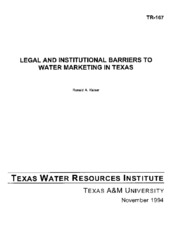| dc.creator | Kaiser, Ronald A. | |
| dc.creator | Boadu, Fredrick | |
| dc.creator | Mertes, James | |
| dc.creator | Barnett, Ann | |
| dc.creator | Phillips, Laura M. | |
| dc.date.accessioned | 2020-10-27T17:23:11Z | |
| dc.date.available | 2020-10-27T17:23:11Z | |
| dc.date.issued | 1994-11 | |
| dc.identifier.citation | Kaiser, Ronald A., Boadu, Frederick, Mertes, Jame, Barnett, Ann, Phillips, Laura M. | en |
| dc.identifier.uri | https://hdl.handle.net/1969.1/191014 | |
| dc.description.abstract | Texas has reached a crossroads in the management of its water resources. Water demand in the state continues to grow while the opportunity to develop new supplies continues to shrink. Urban growth, industrial and tourism development, environmental needs and recreation uses are creating new demands for water. To meet these new demands management practices must shift away from building new reservoirs and pumping more groundwater to conservation and reallocation of existing water. Forecasts in the 1990 Water for Texas Plan suggest that increases in water use efficiency and conservation could reduce municipal water use by 21 percent and agricultural water use by nearly 40 percent by the year 2020. Even with these conservation savings new demands for water cannot be met without reallocating some water.
Water can be reallocated by the cancellation of unused water rights or by the voluntary transfer of water rights between willing buyers and sellers. Water marketing is particularly suited for meeting the new water demands because it encourages voluntary transfers rather than forced reallocations and because it moves water from lower valued agricultural uses to higher valued urban uses.
Transferring water through marketing will have implications for agriculture. Given that agriculture consumes about 70 percent of the total water in the state many of the important conservation and transfer issues will involve the movement of water from agriculture to municipal, industrial, environmental and recreational uses.
The 1990 Water Plan points out that Texas does not have a formal or effective mechanism to promote water transfers or reallocation to more efficient uses. It recommends a review of state water law and regulations to identify restrictions on water transfers and to recommend changes to encourage voluntary water transfers. | en |
| dc.description.sponsorship | Texas Water Development Board; Texas Agricultural Experiment Station | en |
| dc.language.iso | en_US | |
| dc.publisher | Texas Water Resources Institute | |
| dc.relation.ispartofseries | Technical Report;167 | |
| dc.rights | CC0 1.0 Universal | en |
| dc.rights.uri | http://creativecommons.org/publicdomain/zero/1.0/ | |
| dc.subject | water marketing | en |
| dc.subject | water conservation | en |
| dc.subject | legal | en |
| dc.title | Legal and Institutional Barriers to Water Marketing in Texas | en |
| dc.type | Technical Report | en |
| local.department | Other | en |



